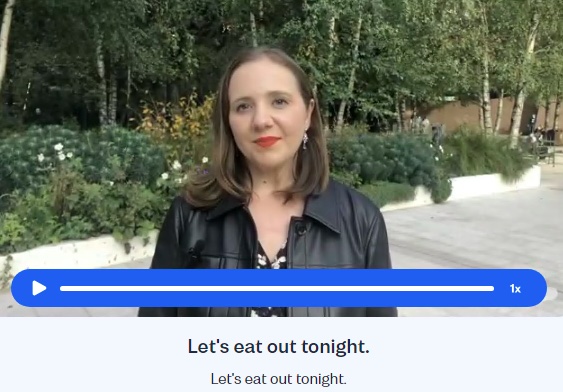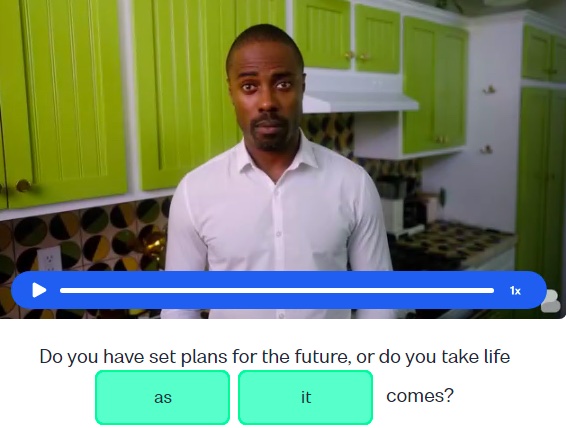Learn the 8 Parts of Speech
Learn all about the 8 parts of speech in English in this guide.
I want to learn...
Think of English like a Lego kit. Just like you can’t build that Star Wars ship without the right blocks, you can’t make English sentences without the right blocks in the right places. These blocks combine and work together to make sentences — each kind of block has its own purpose and rules. These building blocks of language are called parts of speech and understanding them is essential for language learners.
In this article, you’ll learn all about the English parts of speech.
Curious to know more about parts of speech in English?
In the sentence "Let's eat out tonight.", you will learn that it's made up of parts of speech. "Let's" functions as a verb phrase suggesting an action, while "eat" is the main verb, and "out" and "tonight" provide information about the location and time. Learn more via Busuu’s free online courses!
What are parts of speech?
Parts of speech are the different categories given to English words depending on the word’s function in a sentence. In English, there are eight parts of speech: Nouns, pronouns, verbs, adjectives, adverbs, prepositions, conjunctions, and interjections. Each word in English fits into one of the eight groups depending on its role in sentences.
The eight parts of speech
Let’s break down the eight parts of speech in English and check out some parts of speech examples:
1. Nouns
Nouns are naming words. They’re the names we give to people, places, things, and ideas — words like “John,” “France,” “water,” and “emotion” are nouns.
There are two types of nouns: Proper nouns and common nouns. Proper nouns are words for specific things and start with a capital letter, like “California,” “Disney,” and “Cristiano Ronaldo.” Common nouns are general labels for things and don’t need a capital letter (unless they’re at the beginning of a sentence). Examples are “state,” “company,” and “athlete.”
When you speak, don’t worry about the difference between these two nouns — there’s no way to add a capital letter when you talk! But, when you write, you need to be aware of the difference.
2. Pronouns
Pronouns are words we use so we don’t have to repeat specific nouns.
Let’s look at an example: Jane wanted to go to South America. But her parents said it was dangerous there so she didn’t go.
In this example, there are two pronouns: “It,” and “she.” Because the reader or listener knows we are talking about Jane and South America, there’s no need to use those words again in the second sentence. Instead, we can substitute the word for the pronouns.
Pronouns help you avoid repetition which can get boring and confusing for your listeners or readers. They also help your language flow smoothly from one sentence to the next.
3. Verbs
Verbs are action, feeling, or state words. Verbs are the beating heart of your sentences and clauses — without one, you can’t make a complete sentence. Words like “explode,” “go,” “jump,” and “yearn” add energy to your sentences. They add action and motion to bring your language alive. (Check out our article also on irregular verbs)
There are two types of verbs: Action verbs and stative verbs. Action verbs describe action and movement.
Stative verbs describe thoughts, emotions, and senses. Here’s a list:
Table of action and stative verbs
| Action verbs | Stative verbs |
|---|---|
| 1. Answer 2. Build 3. Climb 4. Dance 5. Explore 6. Fix 7. Grow 8. Help 9. Inquire 10. Jump 11. Kick 12. Laugh 13. Move 14. Paint 15.Run |
1. Adore 2. Believe 3. Desire 4. Envy 5. Feel 6. Hate 7. Imagine 8. Know 9. Love 10. Own 11.Prefer 12.Remember 13. Seem 14. Understand 15. Want |
4. Adjectives
Adjectives are words that add description to nouns. They add color, size, shape, etc to the nouns in your sentences. They’re the difference between “It’s a house,” and “It’s a small but cozy, Victorian-era house.”
Adjectives often go right before the noun they describe so they’re easy to spot. (Check out our article about personality adjectives.)
5. Adverbs
Adverbs are a versatile part of speech that modify verbs, adjectives, and other adverbs.
Let’s look at some examples:
John talks loudly, even at night.
Here “loudly” is the adverb and it modifies the verb “talk.” This kind of adverb describes how something is done and they often end in the suffix “-ly.”
He was quite late last night.
In this example, the adverb (“quite”) modifies an adjective (“late”). This kind of adverb shows to what extent the adjective is true. Other examples of this kind of adverb are “more,” “too,” and “very.”
She dances surprisingly well.
In this example, there are two adverbs “surprisingly” and “well.” “Surprisingly” modifies “well.” And they both modify the verb (“dances”).
Now you are getting to know the different parts of speech!
Continue practicing via Busuu and learn to form English questions like "Do you have set plans for the future, or do you take life as it comes?" and know that it contains the 8 parts of speech that include verbs, pronouns, adjectives, nouns, prepositions, articles, conjunctions, and subordinating conjunctions.
6. Prepositions
Prepositions show relationships between the words in sentences. They come before nouns or noun phrases and show direction, time, and place.
Here’s an example sentence:
He put his wallet on the table before he went to bed.
Without the prepositions (“on,” and “before”) we wouldn't know where he put his wallet or when he did it.
Here are twenty of the most common English prepositions:
- Above
- Across
- After
- At
- Before
- Behind
- Below
- Beside
- Between
- By
- During
- For
- From
- In
- Of
- On
- Over
- Through
- To
- With
7. Conjunctions
Conjunctions are the glue of English. These linking words connect words, phrases, clauses, sentences, and paragraphs together so the language flows.
Simple words like “and,” “but,” “so,” are called coordinating conjunctions. They join words or phrases that have the same grammar. For example, a noun and another noun, or an independent clause (a clause that could be a sentence on its own) and another independent clause. The seven coordinating conjunctions are “and,” “but,” “so,” “or,” “for,” “yet,” and “nor.”
Here’s an example sentence: I was tired so I went to bed.
In this example, both “I was tired,” and “I went to bed” are complete thoughts and could be sentences on their own. That’s why you need to use one of the seven coordinating conjunctions.
There are also subordinating conjunctions that connect an independent clause to a dependent clause (a clause that can’t be a sentence on its own).
Here are 15 of the most common:
- Although
- As
- Because
- Before
- If
- Since
- Than
- That
- Though
- Until
- When
- Whenever
- Where
- Whereas
- While
And here’s an example sentence: Because I was tired, I went to bed.
Here the first clause is a dependent clause. “Because I was tired” is not a complete thought so it can't be a sentence on its own. It needs the second clause to complete the thought. The second clause, on the other hand, is a complete thought and could be a sentence on its own. When you make sentences like this, the subordinating conjunction comes at the beginning of the dependent clause — the one that couldn’t be a sentence on its own.
8. Interjections
Interjections are words that express emotions that often come on their own, in their own sentence. They’re a huge part of common, everyday communication.
Some interjections can only ever be interjections, they’re called primary interjections. They don’t have any other meanings and often have no standard spelling — as they’re mostly a part of spoken communication, people write them in different ways. It might be useful to think of them as sounds instead of words.
Here are some common primary interjections:
- Aha
- Boo
- Eek
- Eh
- Ha ha
- Hmm
- Oh
- Ouch
- Phew
- Ugh
- Uh-oh
- Um
- Whoa
- Wow
- Yay
And here’s an example sentence: Ouch! Don’t do that — it hurts.
There are also secondary interjections — words that you can use as other parts of speech in sentences (that means they can be nouns, verbs, or adjectives too). Examples are “amazing,” “no way,” “unbelievable,” dear me,” etc.
Here’s an example sentence: No way! I can’t believe he spent so much on a car.
In this example, both “no” and “way” function as different parts of speech. “Ouch” from the first example doesn’t and can only ever be an interjection.
Words with more than one role in a sentence
To make things more confusing, some English words can be multiple parts of speech. Some nouns can be adjectives and some adjectives can be nouns. Some verb conjugations (-ing and -ed forms) act as adjectives.
Here are some example sentences that show you how this works:
The library bookshelves were filled with a range of books.
“Library” is a noun but in this sentence, it acts as an adjective because it modifies the other noun: “Bookshelves.”
The rich often donate generously to charity.
“Rich” is an adjective. But in this sentence, it acts as a noun and the subject of the sentence.
The destroyed building is a reminder of the natural disaster.
“Destroyed” is the past participle of the verb “destroy,” but in this sentence, it’s acting as an adjective by modifying the noun “building.”
Understanding parts of speech is key to learning a language
Parts of speech are the building blocks of English. And learning these eight categories is an important step in your language learning. Analyze the English you see, try and identify the parts of speech, and keep practicing. You’ll master the parts of speech in no time.
Master English with Busuu
With Busuu, you're just a few swipes away from millions of Native English speakers to interact with. Join our community, complete free English courses, and develop your English skills. All on your mobile device.

